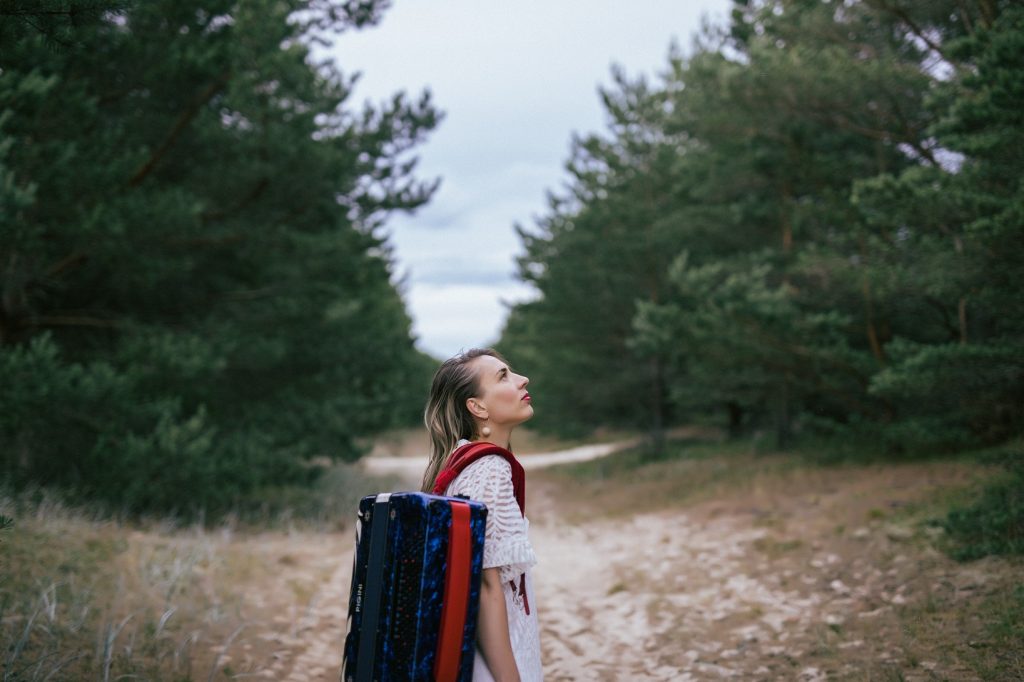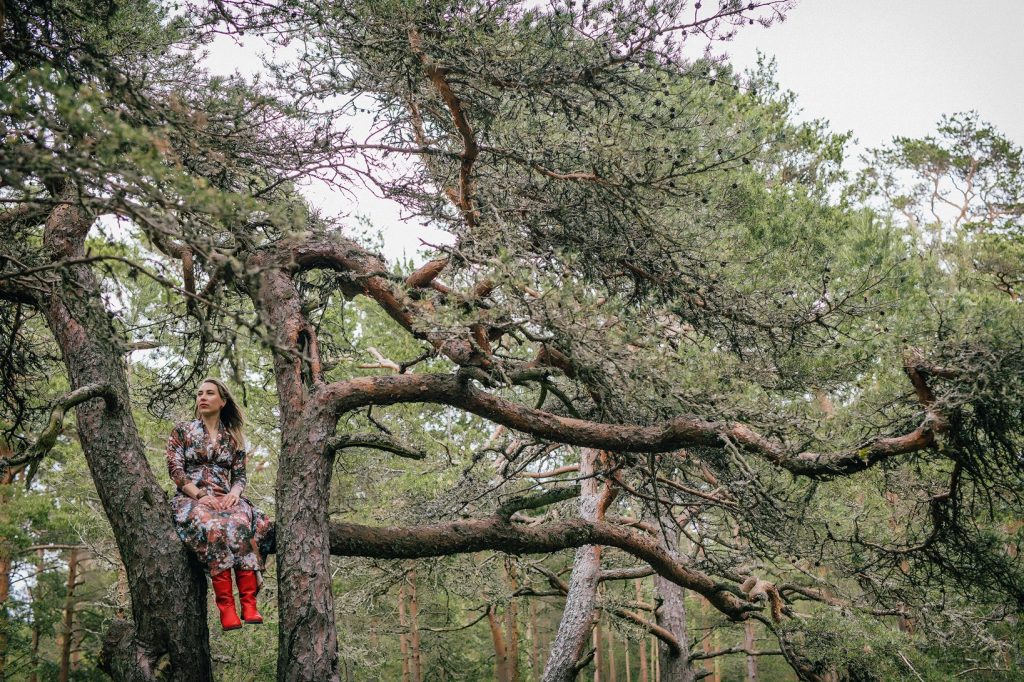Justin Petrone sat down with the Estonian folk musician, Tuulikki Bartosik, in Viljandi to talk about her albums, her life as a musician and how, despite practical difficulties as an accordionist, playing the instrument is liberating and like an extra pair of lungs for her.
Tuulikki Bartosik is one of the better-known names in the Estonian folk music and she has developed an international reputation for her innovative work on the free bass accordion. Born in Rakvere in 1976 and raised between Tallinn and her grandmother’s home in Võru County, southeastern Estonia, she has been a musician for most of her life.
In 2016, she had what might be described as a musical epiphany or reawakening when she released three albums in the same year: Chatterbox, with British accordionist Hannah James; Upa-Upa Ubinakõnõ, a Võru-language album with fellow Estonian musicians Mari Kalkun and Ramo Teder; and her debut solo recording, Storied Sounds.
Her latest record, Tempest in a Teapot (Torm Veeklaasis) was released on the Playing with Music label in Estonia and Sweden in September, followed by a release across Europe on the Nordic Notes label in November. She wrote and played all the instruments on the album, including her free bass accordion and a 12-string Estonian kannel. The album was inspired in part by Bartosik’s treks across the Baltic Sea (she resides between Stockholm and her cottage in Võru County). In the summers, she also organises an international music camp for children and youngsters in Rõuge, a small borough in Võru County.
Some of the lyrics on the new album were written by the Estonian poet Artur Adson, who fled to Stockholm during the Second World War and formed part of the emigre community there. I recently sat down with Bartosik at the Folk Music Centre in Viljandi before one of her concerts to talk about the album and her life as a musician.
Why would someone choose to be a musician? In the past few months, you have been in England, Scotland, Wales, Italy, Finland, Estonia and Japan. You always have to promote yourself and perform if you want to make a living as a musician. Don’t you have to be sort of crazy to do that?
I was thinking about this while watching the TV programme, “Plekktrumm” (an interview programme on the Estonian Television – editor), with Luukas Ilves (a digital expert and the son of a former Estonian president, Toomas Hendrik Ilves – editor). He had so much to say, everything was so thought through, even down to the small details, so interesting. My mother said, “He’s so clever!” and it reminded me of when I was little and what I was told I should learn, should be good at, it was all about that in my childhood. People seemed to know what was best for me, what could make me a better person.
I remembered how lost I was in all of that, and the only thing that was liberating was music. No one could come in and tell me how to play things. I never let anyone do that. I could play my scales and so on, but it was just me and my music. I was not accepted to the number one music school. They said I had an average pitch. I was seven years old at that time. After that I was left alone. It was so liberating and I could choose my own path instead.

Some would have quit and said, “I am not a musician.”
I never had that feeling. I was free the whole summer after that, the summer after first grade, I stayed with my grandmother for a few weeks. I found my dad’s old accordion. I stayed inside in my bikini, and I could already read music, found some sheet music, and I thought, okay, here we go. I learned to play the tunes. I immediately enrolled myself into the accordion class in secondary school.
That was not fancy, it required no exams. I just went there, said, “Hello, I want to play the accordion.” After that, I was always left in peace to play my instrument. I just did my thing. Of course, I played the piano. I played the classics, but it never disturbed me, and I just played my accordion. That’s the way it was. It was so liberating.
You’ve been playing since you were a child. Did it become a part of your identity at a young age? When did you realise you were a musician and not just a kid playing the accordion?
This was happening from early on because my father is a musician. He only played with men, though, but I guess that was the spirit during that time. My dad had a cool dance music band. He was usually on the road from Thursday to Sunday. I was always fascinated. I got to hang around with these cool guys, and as soon as I could, I would play around with my father’s friends. I still do sometimes.
When did you give your first concert as a solo accordionist?
It wasn’t so long ago. After I finished my classical studies, I was a bit traumatised by solo playing. There was so much pressure. Preferably you had to be a serious male player who can play everything perfectly. That is what I saw around me. If you were that, maybe you had the possibility to succeed in the classical world. I discovered it wasn’t my cup of tea and I never saw any income coming from that. I was about 18. So I stopped solo playing. That is why I played in duos, trios, bigger bands. But from 2016, I thought it was time to get over the trauma. I felt more confident.

Estonian musicians remind me of hip-hop artists, in that every hip hop album is full of guest appearances, people rap on each other’s records. Is that how you have operated, as an ad hoc performer? Jumping in on other people’s records?
Estonia is such a small country and our folk and traditional music circles are even smaller, so it is kind of normal to play together in different constellations. There is a supportive spirit among folk musicians.
I came out with my first solo album in 2016. I had another record with Mari Kalkun and Ramo Teder before that and the huge project with Estonian Folk Orchestra in 2014, which resulted in the Imemaa-Wonderland album and a small Swedish tour. There were about 34 musicians in the orchestra, all of them studying folk and traditional music in Viljandi and Tallinn at the time. We got to know each other really well. It is still a big community and it feels natural to jump in on other people’s records.
What was the record with Mari and Ramo called again?
Upa-Upa Ubinakõnõ.
Yeah, that one. I can’t even say it.
Well, I made three albums at the same time. Chatterbox, Upa-Upa Ubinakõnõ and Storied Sounds. I have known Mari for many years. She is also from Võru County. She has always been strong in her musicianship. I have always admired her strength to be alone and to do her thing. We have discussed how the classical world took the fun out of things for me. I think that the same thing never happened to her.
I had to get rid of this no-fun feeling, so that the accordion was recreated for me. The moment I don’t need to go back into that uncomfortable feeling of not being enough, because you were never enough, especially girls, we could never be enough, no matter how hard we practised. After Upa-Upa, I started more and more to get in touch with my Võru County roots and enjoy singing again. I am forever thankful that we did this album. Fun entered into my life again.
One thing I have noticed is that you have some maritime influences in your work. Why are you inspired by the sea?
It’s the first time I really have noticed it, because it’s always been the forest in the past. It still is the forest, but on my new solo album, Tempest in a Teapot, I did research about South Estonian writers and poetswho ended up in Sweden, such as Artur Adson. Adson still wrote in the Võru language (a dialect of Estonian – editor) while living in exile.
Võru is my childhood language. It used to be considered low to speak the Võru language when my mother was a child. She didn’t want to emphasise it, but I have been influenced by it a lot. I lived in Võru County when I was a child, and then my parents brought me to kindergarten in Tallinn, but it never felt like home. I ran away from kindergarten three times. That makes me think again about my children. What I do with them will stay with them forever.
It took me quite a long time to find something that feels like me, which I found in Võru County and the forest. But as I have been living in Sweden and Finland and continuously take the ferries across the Baltic Sea, I have been thinking about people who had to take a journey to save themselves. It’s the same sea, the same places, and I can always return to Võru County, but there were plenty of people who could not, and still they were depending on the creative forces we have there. It must have been devastating to look over the sea and realise that you just cannot get back. I have been trying to put those feelings into some of the tunes on my new album.

It’s interesting that Estonia seems to be led by Tallinn, but culturally it seems to be influenced strongly by Võru.
I have already noticed it in my children. My boys are so rooted in Võru County. If we take a trip to Saaremaa (a county and an island off the western coast of Estonia – editor), that’s like going abroad. My father is from Rakvere, his family has been in Viru County for ages. But it never influenced me as much. It was more about trading, business, not so much about culture. On my new album it is the first time I have sung entirely in Võru language as a soloist. So the sea theme is new for me and it has grown out of me, out of my travels. I don’t know where it will take me.
This year is the anniversary of the mass emigration in Estonia, 75 years ago. I have played in London, in Berlin, Stockholm and Helsinki, where I met the exile communities. I felt Estonia was actually very big. It is the usual thought that Estonia is just some fly on the map, but there is a whole Estonia outside of Estonia. History started to open itself for me in a new way. When people went to exile for 75 years ago, they didn’t know what to think. Maybe they thought it would be over in 10 years, freedom would be restored, they could return. That is all very interesting and also painful to research. There is a lot of creative power in Võru County, it has been so for ages.
Have you ever considered playing something other than the accordion?
I do have some hard feelings about my accordion because it is so bloody heavy. I am so tired of carrying it around. Just imagine, you are at a busy airport and you need to go to the restroom, which usually is a tiny cubicle. What do you do there with the accordion on your back, especially if you’re female? It is like constant strength training so I should actually wear training outfits all the time. Or imagine you are on a train. Same story.
You always have to think about what to do with the accordion. Singers can wear all kinds of clothing, but I always have to think about what to wear, how to sit, so that it doesn’t feel uncomfortable. What is the material, so that it won’t get stuck to the instrument during the concert. I wear layers, but I still sweat all the time, because it weighs like 13 kilos, and with a bag it’s 16 or 17 even. And you can’t just take a bus. The bus driver will be mad if you take accordion inside with you, because it looks like a big bag. They don’t get it sometimes. To fly, it’s also complicated.
So the life of an accordionist can be interesting, even without playing music. But I have never dreamed of playing something else. I own an Estonian bagpipe; I can play the bagpipes. But nothing is ever so comfortable as the accordion. It is like an extra pair of lungs for me. I just love it in spite of all the practical difficulties.
You are quite busy. How do you manage all of this?
If you do things that you like to do, and there is a fun factor always present, then there is no question of how you manage. You just live the life you want to live. But if you do something you don’t like, then there is no way to manage. In this way I am always working.
I have this thing that I always have microphones in the car in summer. For example, we went to the Ignalina Power Plant in Lithuania last summer because my husband watched the new popular TV series, Chernobyl. My sons were also very interested. So of course, I had to play there. It was so great. I was sitting in front of those huge reactors. It was so spacey, so airy, you could hear the wind in the background.
Music is always part of my life. It is never separate. It’s never-ending. Sometimes I wish I could just drive a tractor or something, but I know I would immediately notice the sound of the tractor and want to record it.

Let’s talk about composition. It seems to be that folk songs differ in structure from, say, pop songs, which have a very defined structure. A folk song can be played for three minutes, though, or six, or 10.
Sometimes I have intros and outros in my tunes, but I think I am quite influenced by jazz thinking. Such as in instrumental music, where you play the theme and then you improvise. That is not always the case with folk music. You can improvise all the time in small variations.
Sometimes tunes just come to me. You don’t need to do anything. For example, for this set of tunes on the record called “Setting Sail for Freedom,” I read an article about the Estonian refugee ship, a little sloop, that reached the American coast. It was so interesting. I got this feeling in my body that music is going to happen. It feels warm, there is a bit of a tickling sensation, maybe the way a dog feels that has been inside a house too long and then you say, “Let’s go out”. It’s so exciting. You just need to go.
Sometimes it gets done and the music comes immediately. Sometimes I need to work on it. And when it’s done, there is a liberating feeling. I never think if it’s good or bad or if someone will like it, but just that I got it out of my system. And during this process I never think about the structure, what happens, just happens. It is of course different with old traditional tunes which maybe were played during ceremonies or for dancing.
You have also written a Christmas song.
Yes, I really wanted to write a Christmas song for choir. It was meant to be a solo single in the beginning but then I changed my mind and did it for the choir. I’ve worked together with the Stockholm Estonian Mixed Choir and they performed it at their annual Christmas concert on 12 December at Eric Ericsonshallen (Skeppsholmen Church) in Stockholm. The name of the song is “Jõuluks Koju” (“Home for Christmas”). I have translated it into the Võru language too, but it would not have been an easy task for the choir to sing it in Võru, so they sang in Estonian.
Ideally, I would like to do a whole Christmas album in the Võru language. We need to have more Christmas music that is modern, but we also need to preserve the Võru language, so I find it to be the perfect combination. I really hope the Christmas album will be the next one I will record. I have nothing against Frank Sinatra, but every Christmas I hear him and Bing Crosby. I would like to hear something new in my own languages.
Cover: Tuulikki Bartosik. Photos by Krõõt Tarkmeel.

